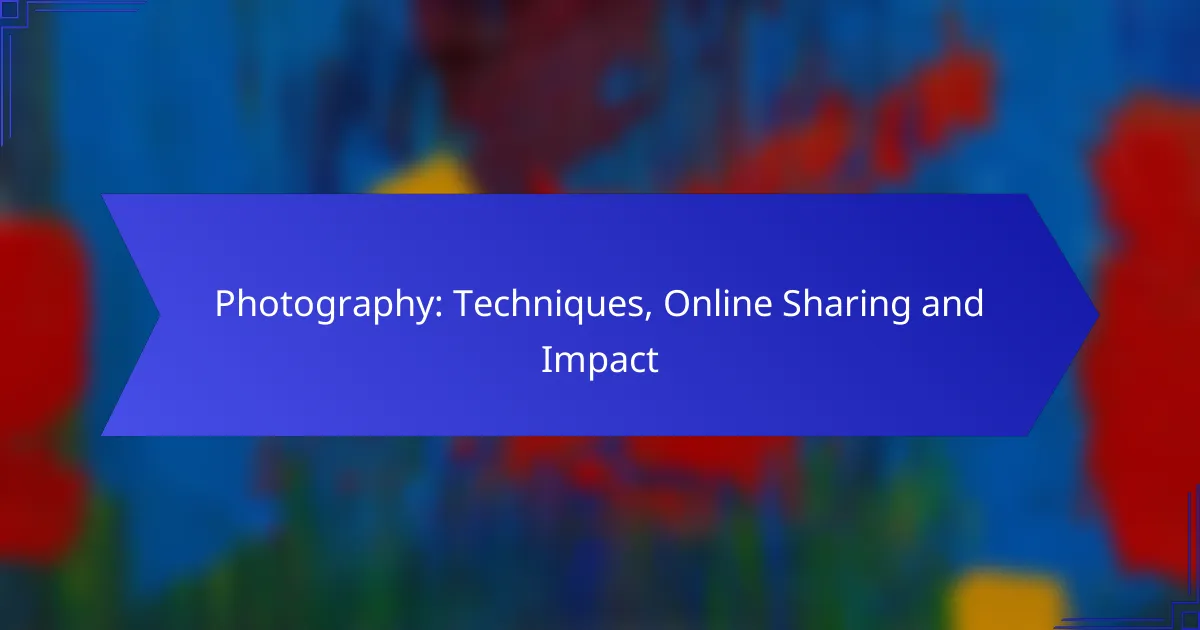Photography is an art form that combines technical skills and creative expression, requiring mastery of techniques such as the exposure triangle and compositional rules. In today’s digital age, sharing your work online is essential, and selecting the right platforms can enhance your visibility and engagement with audiences. By understanding both the technical and social aspects of photography, you can create stunning images and build a meaningful presence in the photography community.

What photography techniques improve image quality?
Improving image quality in photography involves mastering several key techniques, including understanding the exposure triangle, applying compositional rules, utilizing natural light, and effectively post-processing images. Each of these elements plays a crucial role in creating visually appealing photographs.
Exposure triangle: aperture, shutter speed, ISO
The exposure triangle consists of three components: aperture, shutter speed, and ISO. Each element affects the exposure and overall quality of an image. A wider aperture (lower f-stop number) allows more light, while a faster shutter speed freezes motion, and a higher ISO increases sensitivity to light.
Balancing these three settings is essential. For instance, in low-light conditions, you might open the aperture and increase the ISO, but be cautious of noise at high ISO levels. A good starting point is to use the sunny 16 rule, which suggests using an aperture of f/16 on a sunny day with a shutter speed of 1/ISO.
Rule of thirds for composition
The rule of thirds is a fundamental compositional technique that divides an image into nine equal parts using two horizontal and two vertical lines. Placing key elements along these lines or at their intersections can create a more balanced and engaging photograph.
To apply this rule, visualize the grid and position your subject off-center. For example, when photographing landscapes, place the horizon along the top or bottom third line rather than in the middle. This technique enhances visual interest and guides the viewer’s eye through the image.
Using natural light effectively
Natural light can dramatically affect the quality of your photographs. The golden hour, shortly after sunrise or before sunset, provides soft, warm light that enhances colors and textures. Midday light, on the other hand, can create harsh shadows and overexposed highlights.
To make the most of natural light, consider the direction and quality. Position your subject to take advantage of backlighting for a dramatic effect or use diffusers to soften harsh light. Always be aware of changing light conditions and adjust your settings accordingly to maintain image quality.
Post-processing with Adobe Lightroom
Post-processing is a vital step in enhancing image quality, and Adobe Lightroom is a powerful tool for this purpose. It allows for adjustments in exposure, contrast, color balance, and sharpness, helping to refine your images after capture.
Start by cropping your image to improve composition and then adjust the exposure and contrast to enhance details. Use the HSL panel to fine-tune colors and the clarity slider to add definition. Remember to save your edits in a non-destructive format to preserve the original image quality.

How to share photography online effectively?
To share photography online effectively, focus on selecting the right platforms, engaging with your audience, and presenting your work professionally. Utilize social media and portfolio sites to showcase your images while fostering connections with fellow photographers and potential clients.
Using Instagram for visual storytelling
Instagram is a powerful tool for visual storytelling, allowing photographers to share their work with a vast audience. To maximize engagement, use high-quality images, compelling captions, and relevant hashtags to reach your target audience.
Consider posting consistently and utilizing Instagram Stories to provide behind-the-scenes content or updates. Engaging with followers through comments and direct messages can also enhance your presence on the platform.
Creating a portfolio on Squarespace
Squarespace offers an intuitive platform for creating a professional photography portfolio. Choose a visually appealing template that highlights your work and allows for easy navigation. Ensure your portfolio is mobile-friendly, as many users will access it via smartphones.
Include a variety of your best work, organized into categories or projects. Adding an ‘About’ section and contact information can help potential clients reach you easily.
Engaging with communities on Flickr
Flickr is a vibrant community for photographers to share their work and connect with others. Join groups related to your interests to share your photos and receive feedback. Participating in discussions can help you learn from others and gain visibility.
Regularly uploading your work and commenting on others’ photos can foster relationships within the community. Be mindful of group rules and etiquette to maintain a positive reputation.

What equipment is essential for photographers?
Essential equipment for photographers includes a camera, lenses, and accessories that enhance image quality and shooting experience. The right gear can significantly impact the outcome of your photography, making it crucial to choose wisely based on your style and needs.
DSLR vs. mirrorless cameras
DSLR and mirrorless cameras are the two main types of digital cameras. DSLRs use a mirror mechanism to reflect light into an optical viewfinder, while mirrorless cameras rely on electronic displays to preview images.
When choosing between the two, consider factors like size, weight, battery life, and lens availability. Mirrorless cameras tend to be lighter and more compact, making them ideal for travel, while DSLRs often offer longer battery life and a wider selection of lenses.
Choosing the right lenses for portraits
Selecting the right lens for portrait photography is crucial for achieving flattering results. Prime lenses with a focal length between 50mm and 85mm are popular choices due to their ability to create beautiful background blur and sharp focus on the subject.
Additionally, consider lenses with wide apertures (like f/1.8 or f/2.8) to achieve a shallow depth of field. This helps isolate the subject from the background, enhancing the overall composition.
Tripods for stability in low light
Using a tripod is essential for capturing sharp images in low light conditions. A sturdy tripod minimizes camera shake, allowing for longer exposure times without blurring the image.
When selecting a tripod, look for one that is lightweight yet stable, with adjustable height and leg angles. Tripods with a maximum height of around 1.5 to 1.8 meters are versatile for various shooting situations, while those with quick-release plates make it easier to switch between handheld and tripod shooting.

How does photography impact social media marketing?
Photography significantly enhances social media marketing by capturing attention and conveying messages quickly. High-quality images can increase engagement rates, making them essential for brands looking to connect with their audience effectively.
Visual content drives engagement
Visual content, particularly photography, is proven to attract more interactions than text alone. Posts with images can receive up to several times more likes, shares, and comments, making them a vital component of any social media strategy.
To maximize engagement, brands should focus on using vibrant, high-resolution images that resonate with their target audience. Consistency in style and theme across posts can also help establish a recognizable brand identity.
Brand storytelling through photography
Photography serves as a powerful tool for brand storytelling, allowing companies to convey their values and narratives visually. By showcasing products in real-life contexts or highlighting customer experiences, brands can create emotional connections with their audience.
Effective storytelling through images involves selecting visuals that align with the brand’s message and evoke the desired emotions. Incorporating behind-the-scenes shots or user-generated content can further enhance authenticity and relatability.

What are the prerequisites for becoming a professional photographer?
To become a professional photographer, one must possess a solid understanding of photography techniques, camera settings, and the ability to market oneself effectively. Additionally, practical experience and a portfolio showcasing one’s work are essential for attracting clients.
Understanding camera settings
Mastering camera settings is crucial for any photographer. Key settings include aperture, shutter speed, and ISO, which collectively affect exposure and image quality. For instance, a wide aperture (low f-stop number) allows more light and creates a shallow depth of field, ideal for portraits.
Consider experimenting with different settings in various lighting conditions to understand their impact on your photos. A good rule of thumb is to start with the exposure triangle: adjust one setting while keeping the others in mind to maintain a balanced exposure.
Building a personal brand
Creating a personal brand is vital for standing out in the competitive photography market. This involves defining your unique style and consistently showcasing it across platforms, such as social media and a personal website. Use high-quality images that reflect your vision and attract your target audience.
Engage with your audience through storytelling and behind-the-scenes content to build a connection. Networking with other professionals and participating in local exhibitions can also enhance your visibility and credibility in the industry.










